Add this eBook to your basket to receive access to all 307 records. Our indexes include entries for the spelling molesworth. In the period you have requested, we have the following 307 records (displaying 251 to 260): These sample scans are from the original record. You will get scans of the full pages or articles where the surname you searched for has been found. Your web browser may prevent the sample windows from opening; in this case please change your browser settings to allow pop-up windows from this site. Guarantors of the Anglican Church Congress
(1892)
The 32nd annual congress of the Anglican church was held at Folkestone on the 4th, 5th, 6th and 7th October 1892. Moral and social questions were discussed as well as the purely theological and ecclesiastical - The Relation between the Authority of the Bible and the Authority of the Church; the Attitude of the Church towards Labour Combinations; the Work of the Church of England on the Continent; the Result of the Neglect of Religious Instruction in Elementary Schools; Canon Law; the Duty of the Church to the Agricultural Population; Christian Ethics; Meeting of Women; the Temperance Movement; Physical Recreation; the Permanent Value of the Old Testament; Thrift and the Poor Law; Vivisection; Preparation for Clerical Orders, and of Laymen for Evangelism; Foreign Missions; the Duty of the Church towards Soldiers; Christian Doctrine and Christian Life; Preaching in the Church of England; and the Church's Work at the Seaside. The sermons, letters, addresses and discussions (of clergy and laity) were all published in this, the official report of the congress. The congress cost £1,822 14s 1d to hold; the receipts were £1,547 18s 5d, leaving a deficiency of £274 15s 8d, which was raised by call on the guarantors. The full list of the guarantors (who had each pledged from 10s to £200 beforehand) was printed in the official report, and this, together with the names of a handful of donors, is indexed here. | Sample scan, click to enlarge

| Boys entering Westminster School
(1883-1893)
This supplement to the Westminster School Register was published in 1894. It lists boys entering the school from October 1883 to October 1884. They are listed alphabetically by surname and full christian names (in bold), with name, address and (often) occupation of father; sometimes mother's name and maiden name; date of birth; date of admission; and date of leaving. There are further brief notes where the boy had already gone on to university, or was known to have embarked on a career. | Sample scan, click to enlarge

| Associates of King's College, London
(1896)
Former students of King's College, London, could be elected as associates of the college, and then enjoyed the privilege of perpetual free admission to all the classes in the department from which they had been elected; the use of the libraries and museums on the same basis as current students; and admission to dine at high table in the college hall. This list of associates from the college calendar for 1896-1897 gives year of election, full name (surname first), and the faculty or department in which graduated, of all associates elected from 1866 to 1896. | Sample scan, click to enlarge

| Boys entering Manchester Grammar School
(1896)
This Biographical Register of Old Mancunians lists boys alphabetically by year of entering the school. A bare register of entrants existed from 1888 onwards but it was only since the Second World War that any kind of detailed record was kept of those who passed through the school. So, in every case in this printed register, full name is given, in bold, surname first (in capitals); date of birth, and years attending the school; but for the earlier years sometimes there is no more information - or, equally, after investigation among Old Mancunians and published sources, the editors may have been able to furnish a condensed biography. An asterisk indicates a holder of a Foundation Scholarship. In the later years a current address is also given, as of 1964 to 1965, when the book was prepared. | Sample scan, click to enlarge
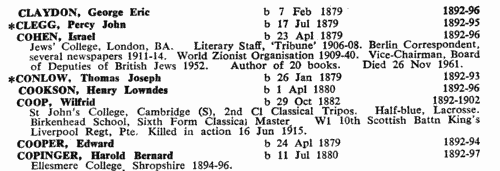
| Retired officers of the Royal Navy and the Royal Marines
(1898)
The Navy List, published by Authority, corrected to 18 December 1898, has this list of the officers on the Retired List of the Royal Navy and the Royal Marines. Each officer's surname, christian name, and any middle initial(s) is given; with rank, and date of seniority in that rank. The ranks are: A, Admiral; A E, Assistant Engineer; A F, Admiral of the Fleet; A P, Assistant Paymaster; Art E, Artificer Engineer; As Ck, Assistant Clerk; B, Boatswain; Bandr, Bandmaster Royal Marines; C, Captain; Car, Carpenter; Ch, Chaplain; Ch B, Chief Boatswain; Ch Cr, Chief Carpenter; Ch E, Chief Engineer; Ch Gr, Chief Gunner; Ch P; Paymaster-in-Chief; Ck, Clerk; Cr, Commander; D I H, Deputy Inspector-General of Hospitals and Fleets; E, Engineer; E Ins, Inspector of Machinery; F E, Fleet Engineer; F P, Fleet Paymaster; F S, Fleet Surgeon; Gr, Gunner; H Sch, Head Schoolmaster; I H, Inspector-General of Hospitals and Fleets; L, Lieutenant; Mid, Midshipman; N C, Naval Cadet; N I, Naval Instructor; P, Paymaster; R A, Rear Admiral; S, Surgeon; S C, Staff-Captain; S Cr, Staff Commander; S E, Staff Engineer; S L, Sub-Lieutenant; S P, Staff Paymaster; S S, Staff Surgeon; Schm, Schoolmaster Royal Marines; St Ma, Sergeant Major Royal Marines; V A, Vice Admiral; W O, Warrant Officer Royal Marines. | Sample scan, click to enlarge
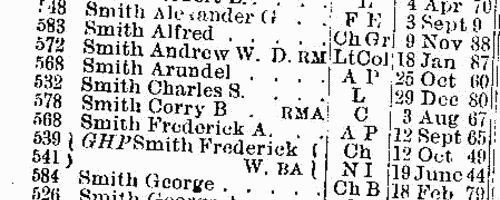
| Unclaimed Naval Prize Money
(1855-1902)
Various prize moneys were awarded to officers and men who served on board her Majesty's ships. For one reason or another a substantial number of these prizes, from as little as a shilling or two to as much as many pounds, remained undistributed by 1902, when this comprehensive list of the unclaimed moneys was printed: it lists unclaimed shares of prize money, slave and pirate bounties, salvage awards, parliamentary grants, gratuities and other moneys distributed by the Admiralty 1855 to 1902, but which omits moneys for service on the China Station during the war of 1856 to 1880, and special gratuities for service in Egypt (1882), Soudan (1884) and Soudan and Nile Expedition (1884-1885), for which there are separate indexes. In each case the sailor's name is given first (surname, then christian name or initials); rank or rating; ship in which serving at time of capture or award; and the amount due. | Sample scan, click to enlarge

| Boys entering Haileybury College, Hertfordshire
(1902)
Haileybury College, near Hertford, was founded by the East India Company in 1806, and incorporated by Royal Charter in 1864. This register of pupils entering the school from 1862 to 1931 was edited by a master there, Laurence Arthur Speakman. The boys are listed by term of joining the school, and then alphabetically by name (in bold), surname first (in capitals). There is then usually a precise birthdate, and the name and address of his father; his period at the school, starting with abbreviations to indicate the house to which he belonged (B., Batten; B. F., Bartle Frere; C., Colvin; E., Edmonstone; Ha., Hailey; Hi., Highfield; L., Lawrence; Le B., Le Bas; M., Melvill; Th., Thomason; T., Trevelyan), and the first and last forms attended (e. g., IV., fourth form). Where a member of a school team there is then an indication (e. g., XI., cricket). For some pupils, with whom the school had lost touch, Speakman was only able to record the details of their time at Haileybury; but for most a brief career synopsis is then given, and current address (as in 1931) or date of death.
| Sample scan, click to enlarge
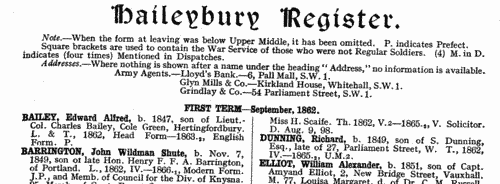
| Boys entering Fettes College, Edinburgh
(1904)
Fettes College, Edinburgh, was opened in 1870 under the terms of a trust 'for maintenance, education, and outfit of young people whose parents have either died without leaving sufficient funds for that purpose, or who, from innocent misfortune during their own lives, are unable to give suitable education to their children'. In 1923 this edition of the Fettes College Register was published; in it the compilers sought to set out for each boy who had attended the college a brief synopsis of what was known about his time at the school, his subsequent career, and date and place of death, or address as of 1923. Of course, for most of the boys entering the school in the early 20th century, their career was still ahead of them. After each name there is a letter in brackets indicating the house to which the pupil belonged - (C.) Carrington House; (G.) Glencorse House; (K.) Kimmerghame House; (M.) Moredun House; (S.) Schoolhouse. An asterisk indicates that the boy was a foundationer, i. e. supported by the foundation; a dagger that he was a foundation scholar. VIA. indicates Upper Form; Mods. Modern School; Army Cl., Army Class; S. P., School Prefect; xx. First Rugby Football Twenty; xv. First Rugby Football Fifteen; xx. cap. Caps occasionally given to the five (or fewer) next to the First Fifteen after 1875; xi. First Cricket Eleven; viii. Gymnastic Eight; Trs. Prizes and Exhib., Trustees' Prizes and Exhibitions; Govs. Prizes and Exhib., Governors' Prizes and Exhibitions; Schol., scholarship; M., married. Month and year of birth is given in square brackets. | Sample scan, click to enlarge
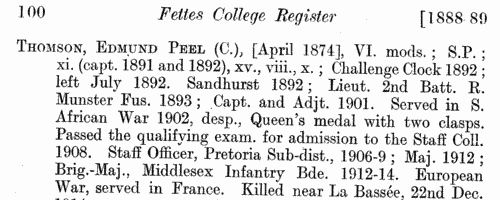
| Indian Civil Servants
(1904)
The India List and India Office List was compiled from official records by direction of the Secretary of State for India in Council, and published by the India Office annually. The volume for 1905 includes this Record of Services, corrected to 1 July 1904. It includes Officers of the Home Establishment of the Secretary of State, Officers of the Covenanted Civil Service, and those appointed under the Native Civil Service Rules, other Officers in Civil Employment in India whose substantive pay was at least 1000 rupees a month, and, with a few exceptions, all officers of those classes who had retired since 1886. | Sample scan, click to enlarge

| Members of the Institution of Civil Engineers
(1904)
The Institution of Civil Engineers was established 2 January 1818, and incorporated by royal charter 3 June 1828. The annual report lists the names and addresses (throughout the world) of the four classes of member - members (M. Inst. C. E.), associate members (Assoc. M. Inst. C. E.), associates (Assoc. Inst. C. E.), students (Stud. Inst. C. E.) - with the dates of admission. This is the index to the Members, which also gives dates of transfer from other grades. The symbols at the left of each page are * for Former Students, + for contributors of papers published in the Minutes of Proceedings, or of an Engineering Conference Note; F for a deliverer of a James Forrest Lecture; L for a deliverer of one of the Special Series of Lectures; and various letters for recipients of certain medals and prizes - B, Bayliss Prize; C, Crampton Prize; f, James Forrest Medal; H, Howard Quinquennial Prize; J, Joule Medal; M, Miller Scholarship; m, Miller Prize; italic m, Manby Premium; S, George Stephenson Medal or Prize; T, Telford Premium; t, Telford Premium; italic t, Trevithick Premium; and W, Watt Medal. | Sample scan, click to enlarge
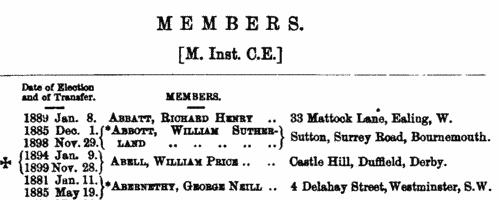
|
Research your ancestry, family history, genealogy and one-name study by direct access to original records and archives indexed by surname.
|











